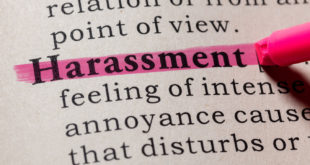For a thing that has caused so many hassles, so many lawsuits, so many hurt feelings, so much wasted time, so much aggravation, such irritation, such anger, such embarrassment, such humiliation, so much absenteeism, so much bad publicity, and so many lost hours of productive work, sexual harassment remains incredibly misunderstood.
For all the laws and workplace rules, many women and men in offices, factories, and stores often feel scant protection. Many others feel they are tiptoeing on eggshells lest they offend. For all the pieces of paper and rule books, most managers feel ill equipped to deal with the realities of harassment, either to do their best to prevent it or to effectively respond if it does happen.
Effective solutions require three things. First, all levels of management need to acknowledge that sexual harassment is not only a violation of basic decency and the right of women and men to have workplaces where they are treated with respect. It is also a very significant bottom-line issues. It is the cause of job turnover, sick leave, and a drop in individual and group productivity.
Expensive lawsuits and fines continue to hit companies. This is most apparent in the US where the government’s Equal Employment Opportunity Commission awards settlements amounting to tens of millions of dollars each year, and that doesn’t include the majority of cases which either don’t go to the federal government or which go through the courts.
Sexual harassment at the workplace is extremely expensive, time consuming, a major cause of workplace tension and job dissatisfaction. It’s bad for business, bad for public services, and bad for millions of managers and staff who just want to get their job done.
The second thing necessary to significantly reduce harassment is effective action by managers. No matter how many workplace codes of conduct we have, harassment will continue until all levels of management are committed to doing effective prevention, responding appropriately, and setting an example.
Unfortunately, far too many managers still go along with harassment. The simple truth is that where there is ongoing harassment of women (or any other group). at least some managers are aware of the problem.
They go along with it for various reasons. For some, they are part of the same old boys’ network that is committing the harassment in the first place.
In other cases where managers aren’t directly involved, they are aware of the problem, but share the biases of those committing the harassment. They sympathize not with the harassed but those committing this breach of dignity and appropriate workplace behavior.
Perhaps the greatest reason for management inaction, though, is that many well-meaning managers don’t have the training necessary to intervene effectively. They are concerned, but haven’t developed the skill set to respond.
As well, there isn’t an adequate range of responses. Often, the only responses are punitive (such as, suspensions or firing.) Such punishment is essential in the worst cases, but if used across the board, can polarize workplaces and return a suspended person to work not better informed, but more angry.
In any case, the first responsibility of managers is to end the harassment and protect those who have been harassed. But they also must restore the workplace, in particular by using this as an opportunity for effective education.
The third requirement to dramatically reduce harassment is to revamp our approaches to workplace training. Current education is simply not effective. Many employees have no training in harassment other than being tossed a manual or pointed to some on-line information.
In the best of cases where there is training, it is inadequate and often boring. Complex problems are reduced to simple formulae and simplistic lists of dos and don’ts.
But in the real world of the office and factory, much sexual harassment is not black and white but in shades of grey. Is it okay to flirt? To complement someone’s appearance? To exchange a hug? To tell a joke with mild sexual content?
The answer is, it depends. It depends on the circumstances, on the relationship of the people, and a dozen other factors. Most of all, it depends on how it makes someone feel. Even that, however, is subject to the standard of what should be a “reasonable” response to certain situations.
Unfortunately, many workplaces with training do not explore these real-world subtleties. The result is employees who are cynical about the issue.
As well, most training does not adequately explore the underlying gender dynamics (or dynamics relating to race, sexual orientation or other factors) that create situations of harassment even if unintended.
Effective remedies to all these problems require an investment of time, money, and energy. My own experiences doing training of staff and management, as well as coaching work with individuals found responsible for harassment, is that most people want a harassment-free environment. Most welcome a chance to learn about these issues in a respectful way. Most managers want tools to deal with the problem. As for the cost of doing this, education is much cheaper than picking up the pieces after problems
occur.
Such training must be designed to be engaging and even entertaining. After all, it’s to make our workplaces better, not make them even more of a drudge. Such training must focus on the subtleties and nuances of harassment and on the underlying gender issues. It must create a climate where staff members feel encouraged to speak out against harassment and to seek support.
Once we do more effective training and give managers a better understanding of the issue and the skills to deal with it, we will have workplaces that are more productive, safer, and more welcoming to all.

 Aliansi Laki-laki Baru Gerakan Laki-laki untuk Keadilan Gender
Aliansi Laki-laki Baru Gerakan Laki-laki untuk Keadilan Gender




